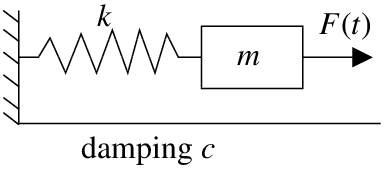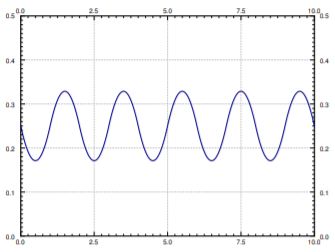15.5: Applications of Fourier Series
- Last updated
- May 12, 2023
- Save as PDF
- Page ID
- 128093
( \newcommand{\kernel}{\mathrm{null}\,}\)
Periodically Forced Oscillation
Let us return to the forced oscillations. Consider a mass-spring system as before, where we have a mass m on a spring with spring constant k, with damping c, and a force F(t) applied to the mass. Suppose the forcing function F(t) is 2L-periodic for some L>0. We have already seen this problem in chapter 2 with a simple F(t).

The equation that governs this particular setup is
mx″
The general solution consists of \eqref{eq:1} consists of the complementary solution x_c, which solves the associated homogeneous equation mx''+cx'+kx=0, and a particular solution of Equation \eqref{eq:1} we call x_p. For c>0, the complementary solution x_c will decay as time goes by. Therefore, we are mostly interested in a particular solution x_p that does not decay and is periodic with the same period as F(t). We call this particular solution the steady periodic solution and we write it as x_{sp} as before. What will be new in this section is that we consider an arbitrary forcing function F(t) instead of a simple cosine.
For simplicity, let us suppose that c=0. The problem with c>0 is very similar. The equation
mx''+kx=0 \nonumber
has the general solution
x(t)= A \cos(\omega_0 t)+ B \sin(\omega_0 t), \nonumber
where \omega_0= \sqrt{\dfrac{k}{m}}. Any solution to mx''(t)+kx(t)=F(t) is of the form A \cos(\omega_0 t)+ B \sin(\omega_0 t)+x_{sp}. The steady periodic solution x_{sp} has the same period as F(t).
In the spirit of the last section and the idea of undetermined coefficients we first write
F(t)= \dfrac{c_0}{2}+ \sum^{\infty}_{n=1} c_n \cos \left(\dfrac{n \pi}{L}t \right)+ d_n \sin \left(\dfrac{n \pi}{L}t \right). \nonumber
Then we write a proposed steady periodic solution x as
x(t)= \dfrac{a_0}{2}+ \sum^{\infty}_{n=1} a_n \cos \left(\dfrac{n \pi}{L}t \right)+ b_n \sin \left(\dfrac{n \pi}{L}t \right), \nonumber
where a_n and b_n are unknowns. We plug x into the differential equation and solve for a_n and b_n in terms of c_n and d_n. This process is perhaps best understood by example.
Example \PageIndex{1}
Suppose that k=2, and m=1. The units are again the mks units (meters-kilograms-seconds). There is a jetpack strapped to the mass, which fires with a force of 1 newton for 1 second and then is off for 1 second, and so on. We want to find the steady periodic solution.
Solution
The equation is, therefore,
x''+2x=F(t), \nonumber
where F(t) is the step function
F(t)= \left\{ \begin{array}{ccc} 0 & {\rm{if}} & -1<t<0, \\ 1 & {\rm{if}} & 0<t<1, \end{array} \right. \nonumber
extended periodically. We write
F(t)= \dfrac{c_0}{2}+ \sum^{\infty}_{n=1} c_n \cos(n \pi t)+ d_n \sin(n \pi t). \nonumber
We compute
\begin{align}\begin{aligned} c_n &= \int^1_{-1} F(t) \cos(n \pi t)dt= \int^1_{0} \cos(n \pi t)dt= 0 ~~~~~ {\rm{for}}~ n \geq 1, \\ c_0 &= \int^1_{-1} F(t) dt= \int^1_{0} dt=1, \\ d_n &= \int^1_{-1} F(t) \sin(n \pi t)dt \\ &= \int^1_{0} \sin(n \pi t)dt \\ &= \left[ \dfrac{- \cos(n \pi t)}{n \pi}\right]^1_{t=0} \\ &= \dfrac{1-(-1)^n}{\pi n}= \left\{ \begin{array}{ccc} \dfrac{2}{\pi n} & {\rm{if~}} n {\rm{~odd}}, \\ 0 & {\rm{if~}} n {\rm{~even}}. \end{array} \right.\end{aligned}\end{align} \nonumber
So
F(t)= \dfrac{1}{2}+ \sum^{\infty}_{ \underset{n ~\rm{odd}}{n=1} }\dfrac{2}{\pi n} \sin(n \pi t). \nonumber
We want to try
x(t)= \dfrac{a_0}{2}+ \sum_{n=1}^{\infty} a_n \cos(n \pi t)+ b_n \sin(n \pi t). \nonumber
Once we plug ![]() into the differential equation x'' + 2x = F(t), it is clear that a_n=0 for n \geq 1 as there are no corresponding terms in the series for F(t). Similarly b_n=0 for n even. Hence we try
into the differential equation x'' + 2x = F(t), it is clear that a_n=0 for n \geq 1 as there are no corresponding terms in the series for F(t). Similarly b_n=0 for n even. Hence we try
x(t)= \dfrac{a_0}{2}+ \sum_{\underset{n ~\rm{odd}}{n=1}}^{\infty} b_n \sin(n \pi t). \nonumber
We plug into the differential equation and obtain
\begin{align}\begin{aligned} x''+2x &= \sum_{\underset{n ~\rm{odd}}{n=1}}^{\infty} \left[ -b_n n^2 \pi^2 \sin(n \pi t) \right] +a_0+2 \sum_{\underset{n ~\rm{odd}}{n=1}}^{\infty} \left[ b_n \sin(n \pi t) \right] \\ &= a_0+ \sum_{\underset{n ~\rm{odd}}{n=1}}^{\infty} b_n(2-n^2 \pi^2) \sin(n \pi t) \\ &= F(t)= \dfrac{1}{2}+ \sum_{\underset{n ~\rm{odd}}{n=1}}^{\infty} \dfrac{2}{\pi n} \sin(n \pi t).\end{aligned}\end{align} \nonumber
So a_0= \dfrac{1}{2}, b_n= 0 for even n, and for odd n we get
b_n= \dfrac{2}{\pi n(2-n^2 \pi^2)}. \nonumber
The steady periodic solution has the Fourier series
x_{sp}(t)= \dfrac{1}{4}+ \sum_{\underset{n ~\rm{odd}}{n=1}}^{\infty} \dfrac{2}{\pi n(2-n^2 \pi^2)} \sin(n \pi t). \nonumber
We know this is the steady periodic solution as it contains no terms of the complementary solution and it is periodic with the same period as F(t) itself. See Figure \PageIndex{1} for the plot of this solution.

Resonance
Just like when the forcing function was a simple cosine, resonance could still happen. Let us assume c=0 and we will discuss only pure resonance. Again, take the equation
mx''(t)+kx(t)=F(t). \nonumber
When we expand F(t) and find that some of its terms coincide with the complementary solution to mx''+kx=0, we cannot use those terms in the guess. Just like before, they will disappear when we plug into the left hand side and we will get a contradictory equation (such as 0=1). That is, suppose
x_c=A \cos(\omega_0 t)+B \sin(\omega_0 t), \nonumber
where \omega_0= \dfrac{N \pi}{L} for some positive integer N. In this case we have to modify our guess and try
x(t)= \dfrac{a_0}{2}+t \left( a_N \cos \left( \dfrac{N \pi}{L}t \right)+ b_N \sin \left( \dfrac{N \pi}{L}t \right) \right) + \sum_{\underset{n \neq N}{n=1}}^{\infty} a_n \cos \left( \dfrac{n \pi}{L}t \right)+ b_n \sin \left( \dfrac{n \pi}{L}t \right). \nonumber
In other words, we multiply the offending term by t. From then on, we proceed as before.
Of course, the solution will not be a Fourier series (it will not even be periodic) since it contains these terms multiplied by t. Further, the terms t \left( a_N \cos \left( \dfrac{N \pi}{L}t \right)+ b_N \sin \left( \dfrac{N \pi}{L}t \right) \right) will eventually dominate and lead to wild oscillations. As before, this behavior is called pure resonance or just resonance.
Note that there now may be infinitely many resonance frequencies to hit. That is, as we change the frequency of F (we change L), different terms from the Fourier series of F may interfere with the complementary solution and will cause resonance. However, we should note that since everything is an approximation and in particular c is never actually zero but something very close to zero, only the first few resonance frequencies will matter.
Example \PageIndex{2}
Find the steady periodic solution to the equation
\label{eq:19} 2x''+18 \pi^2 x=F(t),
where
F(t)= \left\{ \begin{array}{ccc} -1 & {\rm{if}} & -1<t<0, \\ 1 & {\rm{if}} & 0<t<1, \end{array} \right. \nonumber
extended periodically. We note that
F(t)= \sum^{\infty}_{ \underset{n ~\rm{odd}}{n=1} } \dfrac{4}{\pi n} \sin(n \pi t). \nonumber
Exercise \PageIndex{1}
Compute the Fourier series of F to verify the above equation.
As \sqrt{\frac{k}{m}}=\sqrt{\frac{18\pi ^{2}}{2}}=3\pi, the solution to \eqref{eq:19} is
x(t)= c_1 \cos(3 \pi t)+ c_2 \sin(3 \pi t)+x_p(t) \nonumber
for some particular solution x_p.
If we just try an x_{p} given as a Fourier series with \sin (n\pi t) as usual, the complementary equation, 2x''+18\pi^{2}x=0, eats our 3^{\text{rd}} harmonic. That is, the term with \sin (3\pi t) is already in in our complementary solution. Therefore, we pull that term out and multiply it by t. We also add a cosine term to get everything right. That is, we try
x_p(t)= a_3 t \cos(3 \pi t) + b_3 t \sin(3 \pi t) + \sum^{\infty}_{ \underset{\underset{n \neq 3}{n ~\rm{odd}}}{n=1} } b_n \sin(n \pi t). \nonumber
Let us compute the second derivative.
x_p''(t)= -6a_3 \pi \sin(3 \pi t) -9 \pi^2 a_3 t \cos(3 \pi t) + 6b_3 \pi \cos(3 \pi t) -9 \pi^2 b_3 t \sin(3 \pi t) +\sum^{\infty}_{ \underset{\underset{n \neq 3}{n ~\rm{odd}}}{n=1} } (-n^2 \pi^2 b_n) \sin(n \pi t). \nonumber
We now plug into the left hand side of the differential equation.
\begin{align}\begin{aligned} 2x_p'' + 18\pi^2 x_p = & - 12 a_3 \pi \sin (3 \pi t) - 18\pi^2 a_3 t \cos (3 \pi t) + 12 b_3 \pi \cos (3 \pi t) - 18\pi^2 b_3 t \sin (3 \pi t) \\ & \phantom{\, - 12 a_3 \pi \sin (3 \pi t)} ~ {} + 18 \pi^2 a_3 t \cos (3 \pi t) \phantom{\, + 12 b_3 \pi \cos (3 \pi t)} ~ {} + 18 \pi^2 b_3 t \sin (3 \pi t) \\ & {} + \sum_{\substack{n=1 \\ n~\text{odd} \\ n\not= 3}}^\infty (-2n^2 \pi^2 b_n + 18\pi^2 b_n) \, \sin (n \pi t) . \end{aligned}\end{align} \nonumber
If we simplify we obtain
2x_p'' +18 \pi^2 x= -12a_3 \pi \sin(3 \pi t)+ 12b_3 \pi \cos(3 \pi t) +\sum^{\infty}_{ \underset{\underset{n \neq 3}{n ~\rm{odd}}}{n=1} } (-2n^2 \pi^2 b_n+ 18 \pi^2 b_n) \sin(n \pi t.) \nonumber
This series has to equal to the series for F(t). We equate the coefficients and solve for a_3 and b_n.
\begin{align}\begin{aligned} a_3 &= \frac{4/(3 \pi)}{-12 \pi}= \frac{-1}{9 \pi^2}, \\ b_3 &= 0, \\ b_n &= \frac{4}{n \pi(18 \pi^2 -2n^2 \pi^2)}=\frac{2}{\pi^3 n(9-n^2 )} ~~~~~~ {\rm{for~}} n {\rm{~odd~and~}} n \neq 3.\end{aligned}\end{align} \nonumber
That is,
x_p(t)= \frac{-1}{9 \pi^2}t \cos(3 \pi t)+ \sum^{\infty}_{ \underset{\underset{n \neq 3}{n ~\rm{odd}}}{n=1} } \frac{2}{\pi^3 n(9-n^2)} \sin(n \pi t.) \nonumber
When c>0, you will not have to worry about pure resonance. That is, there will never be any conflicts and you do not need to multiply any terms by t. There is a corresponding concept of practical resonance and it is very similar to the ideas we already explored in Chapter 2. Basically what happens in practical resonance is that one of the coefficients in the series for x_{sp} can get very big. We will not go into details here.
- Jiří Lebl (Oklahoma State University).These pages were supported by NSF grants DMS-0900885 and DMS-1362337.


